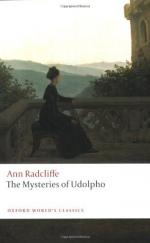|
This section contains 11,796 words (approx. 40 pages at 300 words per page) |

|
SOURCE: “The Spectralization of the Other in The Mysteries of Udolpho,” in The New Eighteenth Century: Theory, Politics, English Literature, edited by Felicity Nussbaum and Laura Brown, Methuen, 1987, pp. 231-53.
In the following essay, Castle points out that although critics of Udolpho usually focus on the gothic episodes of the novel that occur at the castle, the events in the other sections of the book also deserve attention for their fantastical undertones and preoccupation with death and the dead.
Friends came to be possessed like objects, while inanimate objects were desired like living beings.
Philippe Ariès, The Hour of Our Death (606)1
I
When it is not treated as a joke, Ann Radcliffe's The Mysteries of Udolpho (1794) is primarily remembered today for its most striking formal device—the much-maligned “explained supernatural.” Scott, we may recall, was one of the first to blame Radcliffe for supplying anticlimactic “rational” explanations...
|
This section contains 11,796 words (approx. 40 pages at 300 words per page) |

|


